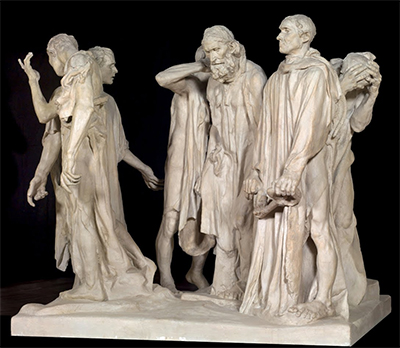Regarded as one of Auguste Rodin's best works, The Burghers of Calais is a sculpture that exists in 12 original castings, plus many copies. This art of work commemorates an event that occurred during the 1337-1453 Hundred Years' War when a major ferry port in France known as Calais was under attack by the English for around 11 months.
Calais commissioned Auguste to make the sculpture in the year 1884; the work was finished in 1889. Calais City had tried to erect Eustache de Saint Pierre's statue since 1845. Eustache was the eldest of the burghers. Earlier, two artists were stopped from creating this sculpture: Auguste Clésinger was prevented by the Franco-German War while David d'Angers (born Pierre-Jean David) by his death. In 1884, Calais municipal corporation invited a number of artists, one of them was Rodin, to submit proposals for this project.
Rodin's design was controversial: it included 6 figures instead of just Eustache. The public felt that the design did not have overtly heroic antique elements, which were regarded as integral to public sculpture. The design of the sculptures wasn't a pyramid arrangement plus it did not contain allegorical figures. The sculpture was designed to be installed at a ground level instead of being placed on a pedestal. Furthermore, the burghers weren't presented in a positive form of glory, they display fatalism, anguish and pain. To Rodin, this was, in fact, heroic: self-sacrifice heroism.
The monument was installed in the City of Calais in 1895. It was placed on a huge pedestal in front of a public park called Parc Richelieu, contrary to the wishes of Rodin, who wanted contemporary townspeople to be close to the figures and have a feeling of solitary with them. His vision was realised later and the sculpture was relocated and taken to the newly finished town hall of Calais city, where the sculpture is resting now on a much lower stand.
In the sculpture, 6 men are seen covered in simple layers of sackcloth that are tattered. Their bodies appear malnourished and thin with joints and bones clearly visible. Each and every man is a city councilman or a burgher, of Calais city, and each has his own stance as well as identifying features. However, although these men stand together with familiarity, none of these men is making eye contact with each other. Some figures have their faces covered by raised hands while others have their heads bowed. Some of them try to stand tall, but their eyes are looking steadily and intently into the distance. The figures are neither drawn together by verbal contact nor through physical contact. Instead, they are drawn together by their bare feet, slumped shoulders, plus there is an expression of total anguish.
The artist followed the recounting of the 14th-century French chronicler Jean Froissart, who wrote about the war. According to Jean, Edward III of England made a deal with Calais citizens if they wanted to save their lives plus their native city, they should surrender Calais plus the 6 prominent members of Calais council were to surrender their lives as well. Eustache de Saint-Pierre was the leader of this group, who Rodin has portrayed with a bowed head plus with bearded face positioned towards the centre of the gathering. To Eustache's left-hand side stands Jean d’Aire with his mouth closed, and he's carrying a large set of keys. The remaining men are Jacques de Wissant, Pierre, Jean de Fiennes and Andrieu d’Andres.
When they were leaving, the 6 burghers never knew their lives would be spared. However, Rodin decided to capture the six men the time they came together ready to leave Calais and go to their deaths. He did not capture them when they were eventually released. Instead of portraying the elation of victory, the artist chose to depict that the threat of passing away is real. Moreover, the artist stretched his piece into a circle, which led to the focal point not being just a single figure. This allows observers to view the sculpture from multiple perspectives without a clear leader.
While the 6 men in the sculpture may look fragile, at first glance, the heavy, rhythmic drapery hanging from their shoulders is seen falling to the ground like weights made of lead, anchoring them and forming a mass of strong, firm bodies. Typically, the fabric looks nearly fused to the ground, which conveys the conflict between the desire of these men to live and the duty to save Calais. The artist also included raised parts of the floor under the feet of these six men, which made some of the men in the sculpture appear taller than others, yet they were sculpted to be all around the same average height of an adult male.
During this period, the burghers were not supposed to be viewed as a hierarchal pyramid with Saint-Pierre as the leader, which would have been normal in multi-figure statues, but as a group the same level in status. Rodin brought the 6 men in the sculpture down to street level, allowing viewers to easily gaze into their faces. This enhances the personal connection between observers and the six men.




